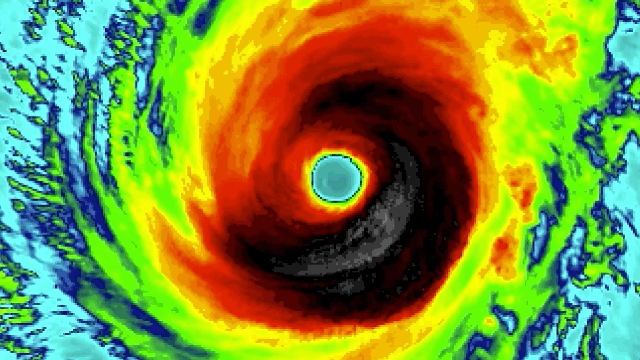We’ve seen a lot of weird-arse tropical cyclones in recent years. This week, we can add another one to the list.
Typhoon Wutip formed and brushed Guam late last week. That alone made it an oddity in terms of timing and location. But rather than weakening as forecast, the storm blew up into a Category 5 monster over the weekend. That makes Wutip the first Category 5 storm of any kind — typhoon, cyclone, or hurricane — ever recorded in the Northern Hemisphere in February.
When we covered Wutip on Friday, all forecasts pointed to the storm wimping out over the weekend. Instead, the storm exploded into a super typhoon, a storm with winds in excess of 241km/h, on Saturday into early Sunday morning. Its sustained winds leaped from from 201km/h to 257km/h in just 12 hours with gusts reaching up to 290km/h, according to the Joint Typhoon Warning Center. That put it well above the previous February record holder, Super Typhoon Higos, which saw winds top out at 241km/h winds in February 2015. It also made Wutip the first February Category 5-equivalent storm to form not just in the Pacific but anywhere in the northern hemisphere.
Wutip also looked the part, with satellite imagery straight out of central casting. The storm had a wide and symmetrical eye at its peak. Both are characteristics of an annular cyclone, storms that tend to be exceptionally strong and usually form over open water.
The storm has since weakened as it chugs toward the Philippines, but what caused the power up seems to have been a bit of meteorological luck. The normal recipe for rapid intensification is weak upper level winds and ocean waters warmer than 30 degrees Celsius. Those conditions are rare in the northern hemisphere in February, though El Niño — which is currently in effect — does tilt the odds towards them slightly in parts of the Pacific. In the case of Wutip, upper level winds were moderate and sea surface temperatures were around 29 degrees Celsius, which was slightly warmer than normal.
Not prohibitive for rapid intensification, but also not a slam dunk. It appears Wutip simply beat the odds.
